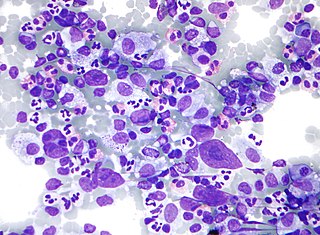Related Research Articles

The Hyphomicrobiales are an order of Gram-negative Alphaproteobacteria.

Brucella is a genus of Gram-negative bacteria, named after David Bruce (1855–1931). They are small, non-encapsulated, non-motile, facultatively intracellular coccobacilli.

The red fox is the largest of the true foxes and one of the most widely distributed members of the order Carnivora, being present across the entire Northern Hemisphere including most of North America, Europe and Asia, plus parts of North Africa. It is listed as least concern on the IUCN Red List. Its range has increased alongside human expansion, having been introduced to Australia, where it is considered harmful to native mammals and bird populations. Due to its presence in Australia, it is included on the list of the "world's 100 worst invasive species".

Hodgkin lymphoma (HL) is a type of lymphoma in which cancer originates from a specific type of white blood cell called lymphocytes, where multinucleated Reed–Sternberg cells are present in the patient's lymph nodes. The condition was named after the English physician Thomas Hodgkin, who first described it in 1832. Symptoms may include fever, night sweats, and weight loss. Often, nonpainful enlarged lymph nodes occur in the neck, under the arm, or in the groin. Persons affected may feel tired or be itchy.
Brucella microti is a species of bacteria first isolated from the common vole, Microtus arvalis. Its genome has been sequenced. It is Gram-negative, non-motile, non-spore-forming, and coccoid, with the type strain CCM 4915T. It is pathogenic.
Brucella inopinata is a Gram-negative, nonmotile, non-spore-forming coccoid bacterium, first isolated from a breast implant infection site. Its type strain is BO1T. It is a potential cause of brucellosis.
Brucella haematophila is a gram-negative, oxidase-positive, non-spore-forming, non-motile bacteria from the genus of Brucella which was isolated from a man in Falun in Sweden.
Brucella pecoris is a gram-negative, oxidase-positive, non-spore-forming, rod-shaped non-motile bacteria from the genus of Brucella which was isolated from genitourinary lymph node of a sheep in Bosnia and Herzegovina.
Brucella pituitosa is a gram-negative, oxidase-positive and catalase-positive, non-spore-forming, non-motile bacteria from the genus of Brucella which was isolated from industrial environment in Sweden.
Brucella pseudogrignonensis is a gram-negative, oxidase-positive, non-spore-forming, non-motile bacteria from the genus of Brucella which was isolated from blood of a man in Göteborg in Sweden.
Brucella thiophenivorans is a gram-negative, oxidase-positive non-spore-forming non-motile bacteria from the genus of Brucella which was isolated from waste water in Germany.
Propionimicrobium lymphophilum is a Gram-positive bacterium which has been isolated from submaxillary tissue.
Camelimonas is a genus of bacteria from the order of Hyphomicrobiales.
Camelimonas abortus is a Gram-negative, rod-shaped and non-spore-forming bacteria from the genus of Camelimonas which has been isolated from placental tissue of a Holstein Friesian cattle in Derbyshire in England.
Camelimonas lactis is a Gram-negative, rod-shaped and non-spore-forming bacteria from the genus of Camelimonas which has been isolated from camel milk in the United Arab Emirates.
Brucella papionis is a Gram-negative, non-spore-forming and non-motile bacteria from the family of Brucella which has been isolated from baboons.
Brucella endophytica is a Gram-negative, aerobic, rod-shaped and bacteria from the genus of Brucella which has been isolated from the roots of the plant Glycyrrhiza uralensis from Yuli County in China.
Falsochrobactrum ovis is a Gram-negative, rod-shaped, non-spore-forming and non-motile bacterium from the genus of Falsochrobactrum which has been isolated from the placenta of a sheep.
Nitriliruptor alkaliphilus is a non-spore-forming and non-motile bacterium from the genus Nitriliruptor which has been isolated from sediments from a soda lake in Siberia in Russia.
Chitinispirillum is a genus of bacteria from the family of Chitinispirillaceae with one known species. Chitinispirillum alkaliphilum has been isolated from hypersaline lake sediments from the Wadi el Natrun valley in Egypt.
References
- 1 2 Parte, A.C. "Brucella". LPSN .
- 1 2 "Brucella vulpis". www.uniprot.org.
- ↑ Parker, Charles Thomas; Garrity, George M. "Nomenclature Abstract for Brucella vulpis Scholz et al. 2016". The NamesforLife Abstracts. doi:10.1601/nm.28642 (inactive 2024-04-17).
{{cite journal}}: CS1 maint: DOI inactive as of April 2024 (link) - ↑ Hofer, Erwin; Hammerl, Jens A.; Zygmunt, Michel S.; Cloeckaert, Axel; Koylass, Mark; Whatmore, Adrian M.; Blom, Jochen; Revilla-Fernández, Sandra; Witte, Angela; Scholz, Holger C.; Vergnaud, Gilles; Al Dahouk, Sascha; Aistleitner, Karin (29 February 2016). "Brucella vulpis sp. nov., a novel Brucella species isolated from mandibular lymph nodes of red foxes (Vulpes vulpes) in Austria". International Journal of Systematic and Evolutionary Microbiology. 66 (5): 2090–2098. doi: 10.1099/ijsem.0.000998 . PMID 26928956.